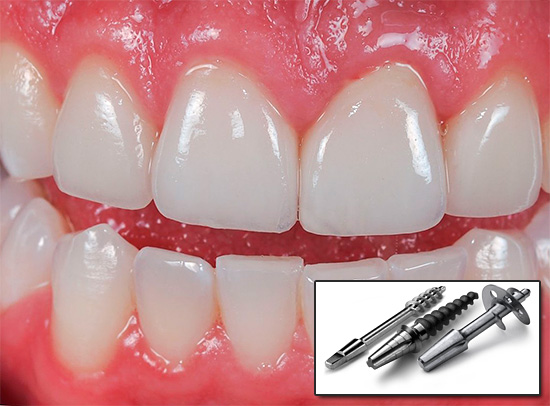
Next you will learn:
- What is basal implantation, what are its pros and cons, pros and cons;
- What are the main stages of implant placement during basal implantation;
- What indications and contraindications exist for the implementation of this procedure;
- How to properly care for implants and how long they can last;
- And is it really possible today to make high-quality basal implantation without fear that complications will begin in a couple of years ...
Basal implantation, around which there are still disputes between supporters (for the method) and opponents (who are categorically against the system), dates back to the 60s of the last century - with the development of the Italian doctor Stefano Tramonte, who began to use his own implant designs with smooth neck and quite aggressive thread. We will talk more about the pros and cons of this technology in more detail.
The main difference between the method of installing basal implants from classical implantation is that the dentist-surgeon installs them in the deep layers and departments of the maxillofacial bone, which are characterized by a special density and resistance to atrophy. That is why such implants are quite long.
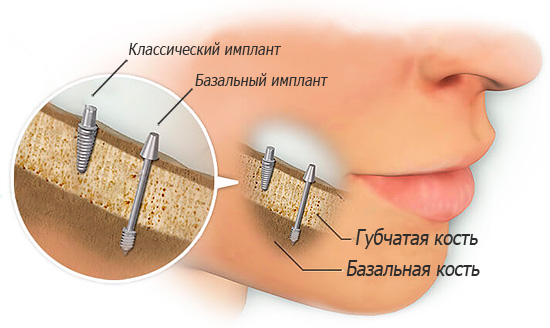
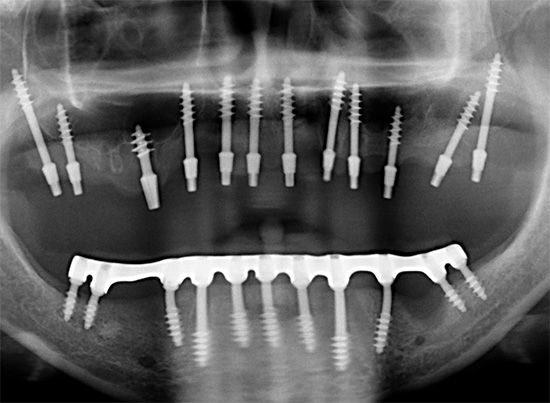
Classical implants are installed in softer spongy tissues of the jaw.
A feature of basal implantation is the ability to install all the necessary implants in one step at a time, and complete the treatment within literally three to five days. But classical and widespread collapsible implants require from 2-3 months to six months of waiting for “engraftment” before the last stage - prosthetics (a long waiting period is one of the drawbacks of classical implantation).
On a note
Basal implants, unlike classical models, can be installed at an angle. This allows you to increase the contact area of the implant surface with bone tissue and at the same time choose the most durable areas of the bone.
A few words about the method of basal implantation
If we turn to history, we can see that basal implantation has existed for almost half a century - exactly as much as the classical technique. However, it was precisely the “classic” that began to develop actively, partly due to the fact that its creators presented the method as more commercially successful. Nevertheless, even in those days, basal implantation had almost identical indicators of implant survival, and today the technique, we can say, is undergoing a rebirth.
The fact that basal implantation is of great interest to patients is understandable. The technique really has many poles: short treatment times, a quick return to a full life and lower costs - all this makes it attractive.
However, the current implantologists were divided into two camps. The first (those who are against the methodology) believe that basal implantation is a short-lived way to restore teeth. Others, on the contrary, advocate a similar system, not only in words but also in practice, demonstrating the positive results of their work and citing reviews of grateful patients as an example.
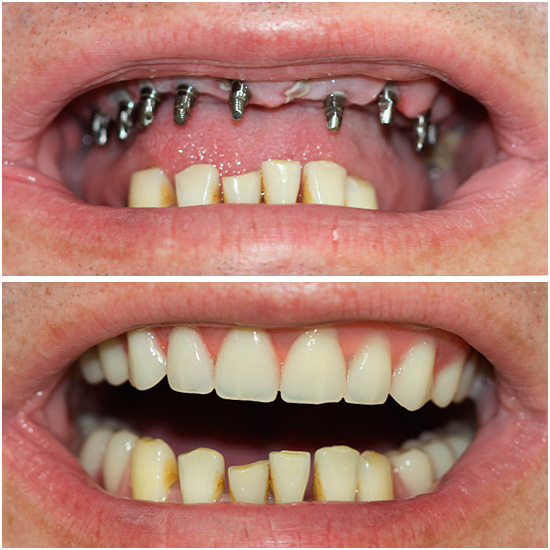
Clinics involved in basal implantation position their services as exclusive - this is often the basis for the advertising campaign of these institutions. In reality, statements about the exclusivity of the services provided are only partly true.
The fact is that in the basal technique there is nothing unique, but it places high demands on the skills and qualifications of a doctor who must:
- Excellent knowledge of the maxillofacial anatomy (after all, you will have to work in conditions of acute atrophy of bone tissue);
- Be able to plan and predict the installation of implants using special software;
- To have good knowledge of orthopedics (after all, it is not enough just to install implants in the jaw - you need to fix them so that you can fix the prosthesis in the future, which is not always easy, especially in a complicated initial situation. In addition, the prosthesis should be convenient, functional and aesthetic) .
It should be borne in mind that the concept of "basal implantation", as such, today is a thing of the past. There is an immediate loading protocol, which includes various technologies for tooth restoration, depending on the clinical picture. It is suitable for both single and multiple restorations, including the complete absence of teeth - a corresponding example is shown in the photographs below:
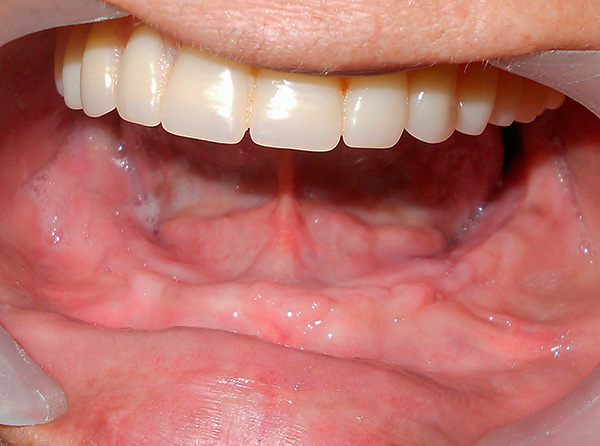
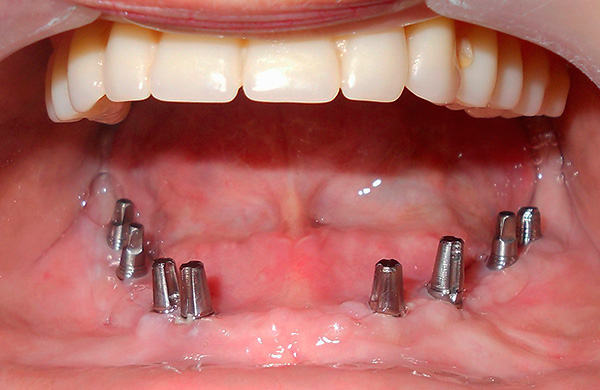
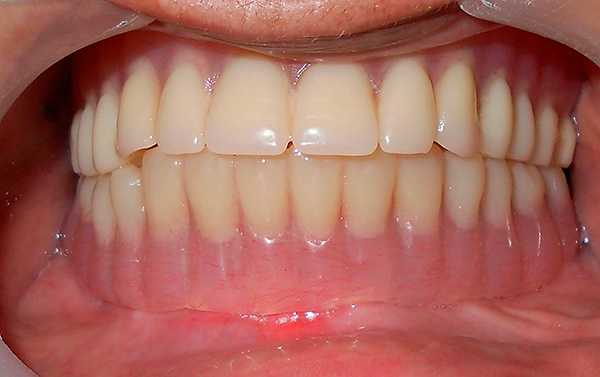
The immediate loading protocol implies an operation in one step, as well as instantaneous (immediate) loading of the prosthesis - hence the name (implantation of teeth with immediate loading, one-stage implantation, simultaneous and other synonyms).
This protocol is also used for single restorations, but is more suitable for patients with complete edentulous or lack of whole tooth segments. Moreover, in cases where atrophic processes in the jawbone tissue are observed, the technique can also be applied through the use of strong and sterile parts of the bone (we will talk more about this later).
On a note
Among the technologies of immediate loading, several main protocols can be distinguished: prosthetics on four implants (all-on-4 - a method patented by Nobel), on six implants (all-on-6) and the basal method itself.
In all cases, implants are used that are installed precisely in the deep layers of bone tissue (there are a lot of models and varieties of such implants). They are attached not only in the alveolar zone, but also in the basal section, the cortical membrane of the bone. And with acute atrophy, the zygomatic bones and buttresses (lines of force) of the skull are additionally used. The degree of fixation of such implants is several times higher and reaches 100 Newtons versus classical implants with an index of 30 to 45 Newtons.
Given the above, basal implantation looks quite attractive (primarily due to the minimum treatment time). But before relying on advertising and positive reviews on clinic sites that say that the patient can get new teeth in just a couple of days, let's figure out why there are so many rumors and speculations around basal implants, as well as which advantages and technologies minuses.
The main stages of implant placement: what should be prepared in advance
The whole process of basal implantation can be divided into 4 stages:
- Diagnostic (preparatory);
- Modeling stage;
- Installation of basal implants;
- Prosthetics.
The diagnostic phase usually takes only one day, but in rare cases is designed for two or more days. The task of the dentist at this stage is to conduct a comprehensive examination of the patient. The maximum emphasis is on the study of bone tissue and the oral cavity as a whole. For this, computed tomography (CT) is mandatory.
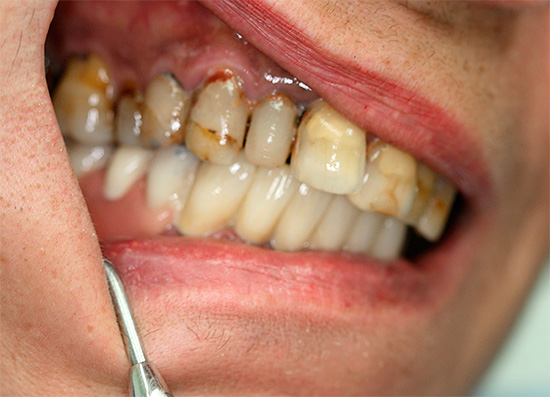
It is important
Many clinics today are equipped with dental orthopantomographs, which are installed directly in the clinic. They are suitable for assessing the quality of endodontic treatment, for planning orthodontic treatment, determining the size of the jaw neoplasms, as well as for classical implantation.
But when working with acute atrophy of the bone due to the low quality of detail, it is better not to use such equipment - computer simulation will be inaccurate. That is why clinics that specialize in basal implantation send patients for diagnosis to specialized medical centers. For comparison: the cost of a dental tomograph is from 4-5 million rubles, and a professional apparatus for diagnosing the condition of any organs of our body - from 20 million rubles.
At the stage of diagnosis, the doctor explains in detail to the patient what to do before the basal implantation of the teeth. Before starting the procedure, it is also necessary to inform the doctor about all diseases, and if necessary, take a blood test and be examined by a profile doctor, as the success of the upcoming treatment may depend on this.
On a note
Today, in individual clinics, there is a practice of not only full-time, but also remote consultation with a doctor. For example, in the case of Moscow clinics receiving patients from the regions, modern technologies, for example, video conferencing or email communication, can be used for initial communication and for exchanging files with CT data.
Then follows the stage of computer modeling - this is one of the key points in the treatment. A doctor often has to work in conditions of acute atrophy of bone tissue, and you need to choose the most accurate place to position the implant (that is, with sufficient bone volume, with minimal risk of hitting nerves or sinuses) - in such cases, computer simulation literally saves the situation.
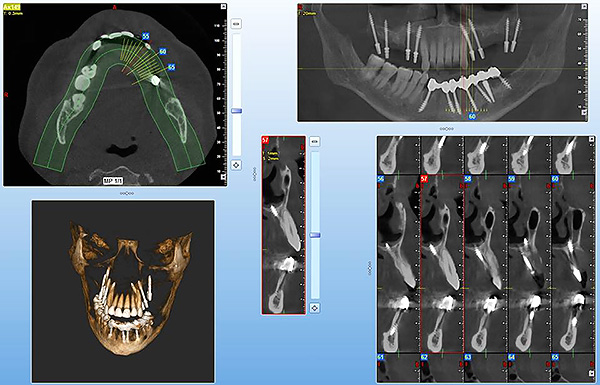
In general, computer modeling during basal implantation is a logical continuation of the diagnostic phase. Information obtained after CT scan is downloaded to a computer. Specially designed software is used to simulate the entire treatment process.
It is interesting
Programs for three-dimensional modeling of the implantation process are issued both by independent companies and can be presented directly by implant developers. For example, Nobel, one of the first companies to produce dental implants, today offers dental laboratories its own Nobel Guide software and even equipment for scanning the oral cavity (instead of taking traditional wax casts).
The computer program helps the doctor analyze the condition of the bone tissue, choose the most suitable place for implantation taking into account the anatomical features of the jaw, and also select the implant design itself.
3D modeling, in principle, can be applied with classical implantation. But its use presupposes the availability of skills to work with it, as well as the availability of special equipment and, in fact, the software itself. Therefore, many dentists do not always use this modern technology (for example, only at an additional cost). When choosing basal implantation, 3D modeling is a mandatory procedure, because it allows the operation to be performed without errors, with maximum accuracy, without complications, with a predicted and guaranteed result.
At the next stage of basal implantation, the actual installation of implants is carried out using the puncture or incision method (or immediately after tooth extraction). A puncture makes it possible to carry out the entire procedure without suturing, and is suitable for people with weakened and inflamed gums.
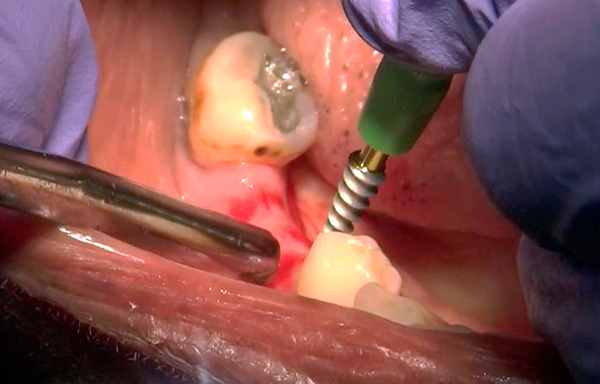
On a note
Based on the simulated data, individual surgical templates are developed using 3D printers. These are usually silicone stencils that are superimposed on the alveolar ridge during surgery. They have openings with a certain angle of inclination through which implants are inserted into the bone.Thus, they are installed in a precisely calibrated location, which makes the operation less risky and less traumatic.
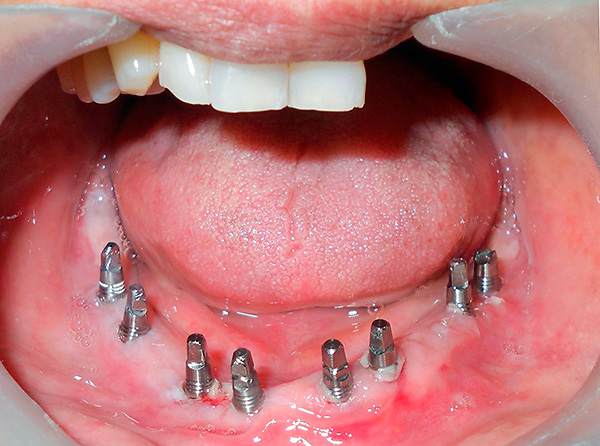
The last stage of basal implantation is prosthetics. After the installation of basal implants, the prosthesis is usually placed for 2-3 days - to create the necessary primary load on it. The prosthesis is made using casts that are removed from the jaw of the patient. At the same time, all installed implants are imprinted on the impression, the spatial relationship of which is studied already by the dental technician who obtained the necessary prosthesis in the dental laboratory (at the same time, the data of the computer model created at the preliminary stage are taken into account).
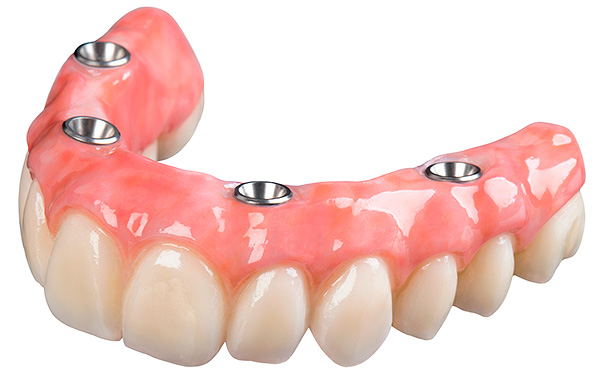
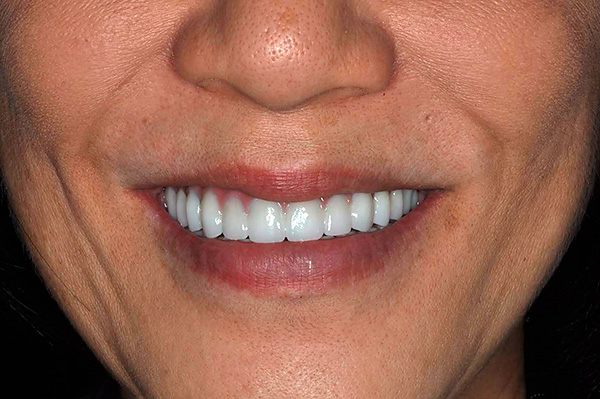
Immediate (immediate) prosthetics plays a very important role in the entire treatment process.
Firstly, the prosthesis immediately transfers the chewing load to the implants, and through them to the bone tissue, due to which natural processes are activated in it, and regeneration proceeds as quickly as possible. Simply put, bone is quickly restored in many respects due to the fact that the patient is able to chew food a few days after the basal implantation.
It is interesting
Basal implantation is based on the use of Wolf’s law, according to which the human bone adapts to the loads that are placed on it. And its internal structure undergoes adaptive changes, after which the state of the cortical shell of the jawbone changes - it becomes more dense, and therefore, more durable.
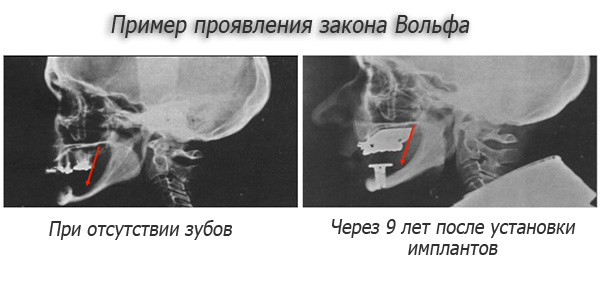
Secondly, the prosthesis connects all installed implants into a single design. If one implant is heavily loaded, it will be displaced under load. But due to the fact that the prosthesis framework combines all artificial roots, they become motionless and calmly take root in the bone tissue, even despite the presence of intense chewing load.
Thirdly, the prosthesis allows the patient to feel full - the aesthetics and the possibility of nutrition are restored with basal implantation almost immediately.
However, there is one very important point (which some may consider a minus). Although after the installation of implants the prosthesis is fixed permanent, not removable, but nevertheless it is a temporary structure. This means that you need to wear it for at least six months, and in practice - up to 3-4 years, until the plastic crowns fail and lose their appearance. After the prosthesis, you will have to replace it with a permanent one - that is, one that has stood idle for decades.
Important!
With significant atrophy of bone tissue, patients are offered a fixed prosthesis, the crowns of which are mounted on an acrylic base or using Acry Free material - a kind of artificial gum. It is small, not very noticeable and practically does not feel in the mouth. Such a system allows you to hide the uneven contour of the natural mucosa, which sags along with the bone.
If you put a bridge made of only crowns, then they will be excessively long. In this case, doctors even use a special term - “horse smile”.
How are basal implants different from classic ones?
Modern basal implants have a classic root shape. They have a slightly longer body and a specific type of carving, since they are fixed deeper and in denser layers than classical dental implants.
But, perhaps, the main difference between basal implants is that they have a solid shape, that is, are combined with abutments (the tops that serve as the basis for the prosthesis).
Basal implants:
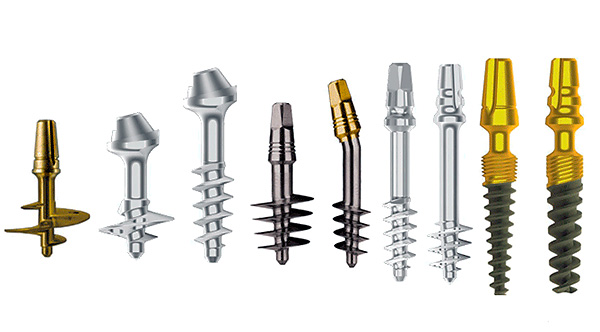
Here are some examples of classic implants:
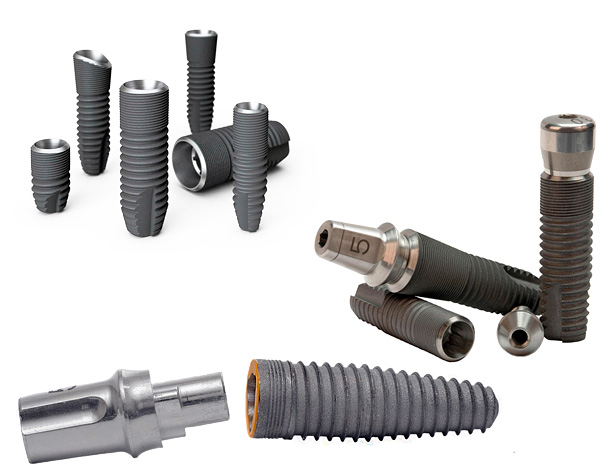
Some doctors consider the integrity of basal implants to be a significant disadvantage, justifying that dental technicians have to “sculpt” prostheses on already installed implants, and if the doctor put them “crookedly”, it will be an almost impossible task to correct his serious mistakes for a dental technician.
To better understand whether this moment can really be considered a lack of basal implants, let's see how the situation usually develops in practice in most clinics.
In classical implantation, an implantologist-surgeon and a dental technician or orthopedist work in tandem. And often even separately from each other. That is, the surgeon installs the implants, and the orthopedist selects the optimal abutments and adapts the position of the prosthesis. And the orthopedist really has a sufficient margin for maneuvers at work.
In the case of basal implantation, the situation is different. An implantologist is often required to be both a maxillofacial surgeon and an orthopedic surgeon in one person, or to work in tandem with a professional orthopedic surgeon, as one unit, since indeed, if the implants are placed crooked, then the prosthesis cannot be installed normally.
That is why, including due to computer modeling, the entire treatment process is carefully planned - from the installation of the implant, the selection of the angle of inclination of the abutment and the study of the possibilities of their load to fixation of the prosthesis. The doctor needs to be fully proficient in the process, since he has to work with acute atrophy, malocclusion, problems in the sinus area, etc. And the patient should get a decent result.
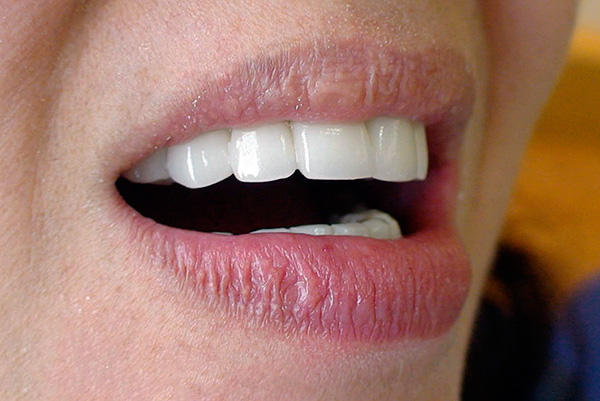
As for the implants themselves, they have a maneuverable tip - that is, the abutment immediately after implantation can be tilted with a special tool to a certain degree, which allows you to align the bite, fix the prosthesis evenly and without displacement.
Thus, if the integrity of basal implants can be considered a certain minus, then only from the point of view that the technology of their installation implies higher requirements for the skills and professionalism of a doctor than in the case of the classical protocol. Simply put, a good doctor will be harder to find.
BOI lateral implants for basal implantation and related horror stories
BOI lateral implants are disc implants that were developed by Dr. Stefan Ide. They have been used for quite some time, and perhaps in some clinics they are still being installed, so it’s useful to find out about what the advertisement will be silent about.
Disc implants made of titanium (as well as basal and classical) were created, and their feature was the base in the form of a disk. Such implants were installed not through the apex of the jawbone, but from the side, by means of drank tissue.
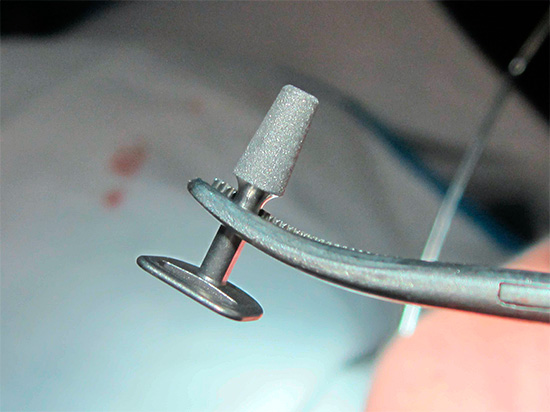
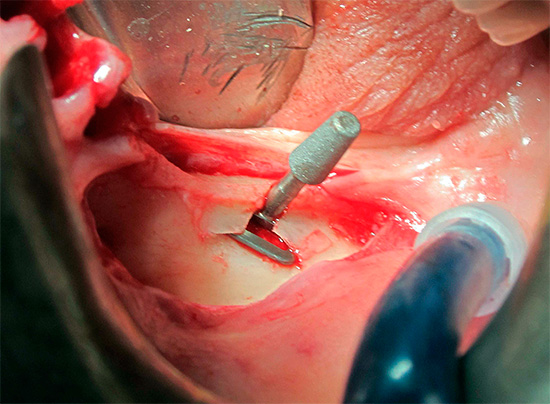
The lateral BOI implants were healed into the basal circles, since they also involved the corresponding part of the bone. However, persistent attempts to use them failed, and there are several reasons for this:
- Too complicated installation;
- They are far from always effective, and only with jewelry accuracy sawing a bone under an implant;
- Long-term postoperative rehabilitation (and as a result, many complications).
Today, not a single professional working on the result will use disk basal implants in their practice.
Disk implants several years ago were actively installed in our country. They were produced under the BOI brand (later their analogues were launched - PEEK implants, which were created not from titanium, but from a biopolymer). And to this day, it is precisely such implants in shape that many patients associate with the basal technique (and often such people are opposed to it).
Below the photo shows examples of disk implants:
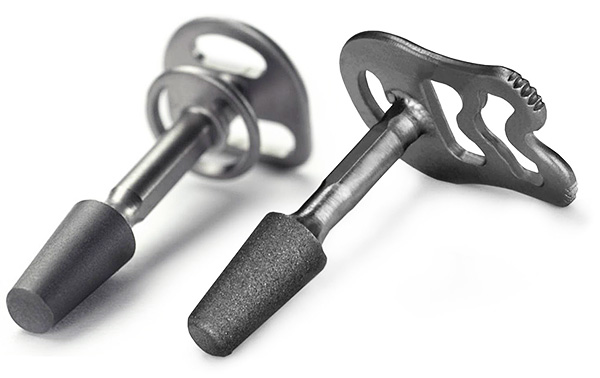
The main disadvantages of obsolete disk basal implants (BOI):
- High complexity of the process for the doctor himself and the dental technician.The inability to correct at its discretion protruding above the gingival part of the already “implanted” implant creates difficulties for both the doctor and technician, and for the patient in the future;
- There are many cases of loss of aesthetics after the final prosthetics. This point is largely interconnected with the previous one, since the system of basal implants delivered “like a hand took” creates the prerequisites for the corresponding “curves” of prostheses. In other words, prostheses look unnatural and do not fit well with periodontal tissues, causing discomfort to patients;
- Severe damage to the gums and bones during the installation of basal implants, suturing;
- In cases of rejection of the implant in the area of its installation, there is a significant loss of bone, requiring replenishment of the bone mass, that is, additional surgery may be required to eliminate the resulting failed implantation "Hole" in the jaw.
Compared to disk implants, modern root-shaped basal implants have significant advantages:
- The treatment process, as well as subsequent prosthetics, is modeled in advance. The angle of inclination of the abutment is adjusted to the position of the prosthesis, therefore, neither the implantologist, nor the dental technician, nor the patient have difficulties;
- The implantologist is a maxillofacial surgeon and is surely familiar with orthopedics, which allows him to perform implant placement taking into account the patient’s bite. Together with 3D modeling, this allows the dental technician to create prostheses with high aesthetics and strength indicators;
- Modern basal implants are installed in a minimally invasive way, without massive tissue incisions and suturing - by puncture. This reduces the risk of complications after surgery, reduces and facilitates rehabilitation for the patient;
- With the correct installation of the implant, the bone tissue not only does not decrease, but, on the contrary, is restored and compacted due to chewing load.
The benefits of basal implantation
So, having considered all the features of the basal implantation method, the following advantages can be distinguished:
- The number of visits to the doctor is minimized;
- A small number of contraindications to this type of implantation;
- Suitable for smokers;
- It is easily tolerated by people in old age;
- Suitable for people suffering from acute forms of periodontitis and periodontal disease;

- You can start chewing prostheses already 3-5 days after implant placement;
- Only one operation is needed: the implants are placed simultaneously;
- Relatively lower cost of services;
- The method is suitable even with significant atrophy of the jaw bone (in other words, with a decrease in its height and reduction in volume);
- Bone healing is faster due to the sparing attitude to it, as well as providing immediate chewing load.
Dentist Opinion
Despite the large number of advantages of the technology, it is difficult to achieve positive results of basal implantation, but it is possible if all stages are performed perfectly. First, the work should be carried out by an experienced doctor who has certificates confirming the right to work with this protocol of treatment (they are issued only by the International Fund for Implantologists). Secondly, the doctor should be not just an implantologist, but a maxillofacial surgeon with thorough knowledge of the anatomy of the jaw system. Thirdly, the implants of companies existing on the market for decades, and not released just a few years ago and taking only the first steps in working with the immediate loading technique, should be used for work.
Some of the “oldies” in this area are Nobel Biocare, Osstem, Oneway BioMED and BioHorizons. For these brands, both positive and negative (which is also important) work experience has been accumulated, and there are also confirmed clinical studies in the long term.
However, in order to objectively evaluate the methodology, it is necessary to know not only its pluses, but also the minuses - let's talk about them further ...
What is important to know about the main disadvantages of technology
The final conclusions about basal implantation as a supposed effective technique can only be made by weighing the pros and cons. The technique really has a large number of advantages, especially for those patients who, due to a long absence of their own teeth, have acute bone atrophy. But, as experts say, not every doctor will decide to use this technology - and this is the main snag.
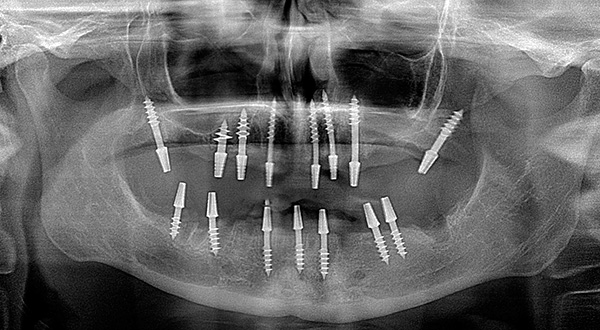
Among the serious drawbacks of the technique, it is necessary to highlight the absence of doctors who are able to install basal implants (and prostheses) according to the relevant rules and protocols. In order to become a professional, you need to go through 5 practical stages of training at the International Implant foundation, which, due to their high cost, is not accessible to everyone.
In addition, increased demands are placed on specialists: the doctor must be both a maxillofacial surgeon, an orthopedic surgeon and an advanced user of computer software for modeling treatment. To help, the doctor should choose a dental technician who is also trained in the specifics of developing prostheses for immediate loading, taking into account the creation of the correct occlusion, so necessary to evenly distribute the load on the bone and not overload the implants (because the prosthesis not only performs the function of a natural and beautiful looking artificial teeth, but it is also an additional stabilizer of implants, preventing their mobility).
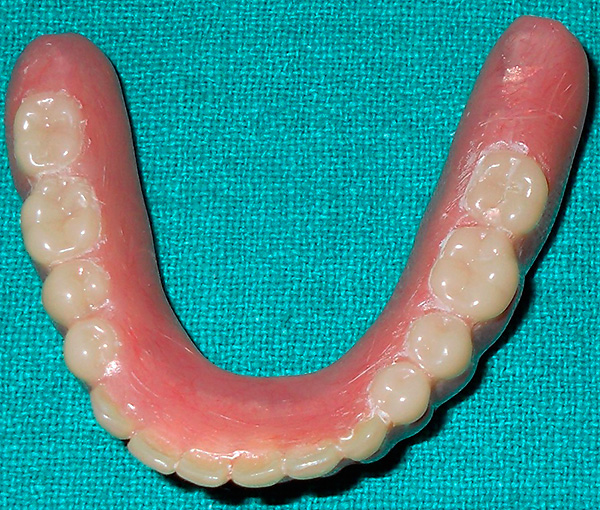
That is why you should not blindly trust the advertising of dental clinics offering basal implantation - you must necessarily weigh the pros and cons, check the doctor’s certificates and look at the results of his practical skills (for example, examine photos with examples showing the patients ’oral cavity before and after treatment) .
The main indications and contraindications for basal implantation
Proponents of basal implantation, as the advantages of this technique, cite the lines from the points of indications to it, since some of them are simultaneously its advantages. Those who oppose focus on contraindications to basal implants, and consider them as cons.
However, indications for the technique give the dentist only approximate information on the treatment forecasts, not guaranteeing a 100% positive result. The explanation is simple: each case is exceptional and unique in its kind, therefore, indications and contraindications should be considered from the perspective of medical logic and common sense, and not standardized.
The following are some indications for basal implantation as an example:
- The need to restore chewing function in a short time (3-5 days);
- Restoration of the jaw bone, as well as teeth in the absence of more than 3;

- Restoration of aesthetics and function of teeth in their complete absence;
- Severe periodontal disease (most often with periodontitis and periodontal disease);
- Decrease in the bone on the upper and (or) lower jaw;
- Smoking;
- Contraindications or unwillingness to do sinus lift (bone extension).
Absolute contraindications to basal implantation are identical to those cases when classical implantation is not performed either (they are even less due to the possibility of treatment for atrophy and inflammatory processes).
With the problems listed below, surgery is not performed in principle:
- Tumor neoplasms;
- Some diseases of the circulatory system;
- Central nervous system disorders;
- Bone regeneration disorders;
- Chronic diseases (tuberculosis, diabetes with a constant need for insulin).
Relative contraindications to basal implantation:
- Treatment with biphosphate preparations;
- Pregnancy and lactation;
- Mental disorders and neurosis;
- Decompensated diabetes mellitus;
- The acute form of arthritis.
The maxillofacial surgeon will never begin implantation until the oral cavity is prepared. Therefore, before starting the procedure, he carries out the treatment of teeth that must be preserved, removes moving or problem teeth with cysts or granulomas on the roots.
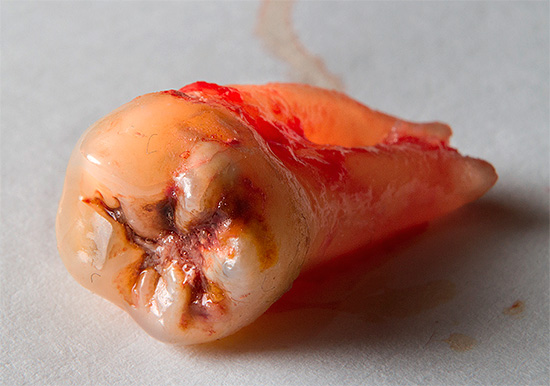
On a note
The technique of basal implantation allows treatment immediately after tooth extraction: an implant is placed directly in a fresh hole (that is, you do not need to wait several months for the bone to recover).
How to care for implants
Implants along with dentures require mandatory care, as their service life directly depends on this. However, do not worry too much, because in order to maintain oral hygiene after basal implantation, you do not need any special knowledge and skills. It is enough to brush your teeth with a brush with toothpaste at least 2 times a day and rinse your mouth after cleaning with antibacterial solutions.
If there are difficulties in areas that are difficult to reach (for example, under bridges, or between dentures), where the bristles of the toothbrush are difficult to penetrate, use an irrigator (this device is designed to remove plaque, food debris and massage the gums with a jet of water, produced under pressure).
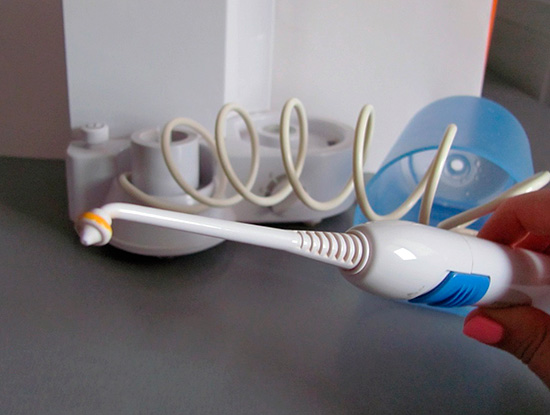
On a note
In the presence of dental implants, floss (dental floss) is not recommended, since there is a high risk of damage to the tissue around the implant.
In order not to worry about the fate of implants and prostheses, you should visit the dentist 1-2 times a year to assess their condition. If primary manifestations associated with any violations are found, their elimination should immediately begin.
It is with the initial manifestations of complications that it is easier and faster to achieve a positive result. Sometimes the usual correction is enough, which is most often carried out under warranty, that is, for free.
Of course, it is important to observe some caution in using prostheses on implants:
- Protect yourself from injuries of the maxillofacial region;
- To prevent a decrease in immunity;
- Prevent acute and chronic infections: regularly evaluate the state of health and conduct timely medical treatment of the initial forms of the disease. It has long been proven that most common diseases of the body directly or indirectly affect the life of the implants.
How many basal implants usually serve?
Generally speaking, the life of basal implants depends on many factors, and it is not possible to predict it in advance, as well as for classical models.
In many respects, the life of basal implants is affected by the accuracy of the orthopedic construction - it depends on whether the prosthesis will provide the necessary parameters for the magnitude of the load on the implants and properly distribute the pressure on the bone tissue.
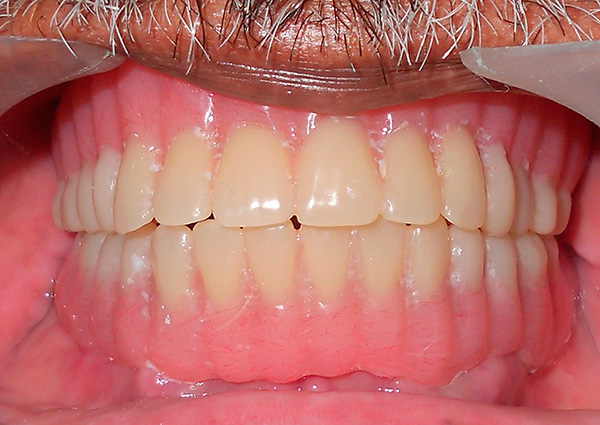
Not the last place in extending the life of a basal implant is taken by regular dental examinations and competent oral hygiene. In other words, the life of the implants substantially depends not only on the doctor, but also on the patient.
With the exact fulfillment of all the rules for the manufacture of a basal implant, as well as with careful and careful attitude to it, the service life may not be limited. Proven and reputable companies that specialize in developing models for basal implantation with an immediate prosthetic load provide a lifetime warranty on their products. On the one hand, this is an advertising move, and on the other hand, it is an additional guarantee for the patient that neither the doctor nor the clinic will abandon him in difficult times in case of any complications.
On a note
The material for basal implants is titanium. It has unique properties that allow for the process of "engraftment" of the implant, fusion with bone tissue (osseointegration).After research, it was proved that pure titanium is an ideally biocompatible material that significantly increases the life of implants.
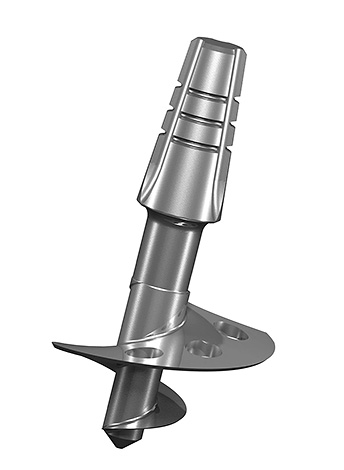
Orthopedic constructions, which are fixed on mounted implants, on average, serve significantly less than “screws”. They are guaranteed for 1-2 years, but their service life is much higher.
The first (adaptive) prostheses are made of metal-plastic. But, unlike classical plastic, diamond crumb is added to it, which helps strengthen the material, makes it more aesthetic and durable. Therefore, in practice, it is perfectly acceptable to wear such prostheses for about 3-5 years.
Ceramic-metal dental bridges (see the example in the photo below) will last an average of 10-12 years.
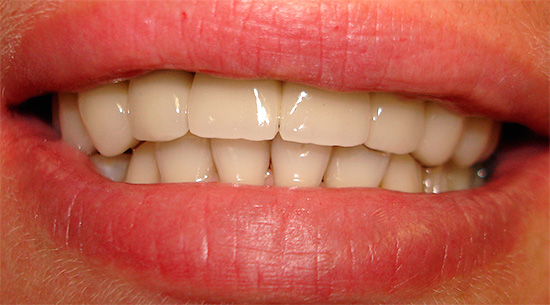
Meanwhile, one of the most reliable and aesthetic is considered to be a zirconia crown with a service life of more than 20 years (but also at the price of manufacturing such crowns will be much more expensive than ceramic-metal ones).
High-quality basal implantation without complications - myth or reality?
One-stage basal implants in the process of development of the technique have undergone many modifications. As mentioned earlier, in the line of basal implantation of the last generation, not only root-shaped implants were used, but also plate BOI implants. Despite the fact that this type of implant has positive long-term results, modern schools of immediate load (Immediate Load) have refused such designs because of the requirements for jewelry skill in installation and a wide range of contraindications.
The peak of popularity of the brand of BOI implants occurred in 2010-2012 in the branches of several dentists in Moscow. The result of the activities of the newly trained doctors who set to work immediately and without due care was that there were numerous negative reviews from patients on the Internet who risked putting similar basal implants on themselves.
Negative opinions of doctors and negative reviews of patients were not unfounded: Moscow clinics, which for several years performed multiple basal implantation on BOI implants, gaining experience, transferred to other owners and ceased to be responsible for the results of previous 2-3-year work in Russia .
An analysis of most of the feedback from the “victims” showed that the BOI basal implants installed during this period did not begin to “be rejected” right away: someone was lucky to walk a year and a half with a “new thing”, and some “lucky ones” reached 3 years.
In the photo - periimplantitis (inflammation of the bone and soft tissues in the area of the implant):
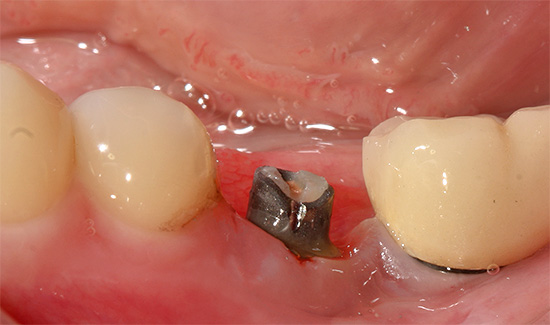
Feedback:
"Hello! My name is Oksana, 46 years old, I live in Khimki, Moscow Region. In 2010, in Moscow, I put a variety of basal implants - BOI implants on both jaws. The contract contained a guarantee for implants of 25 years, and for prostheses installed on them - 3 years. Only 2 years have passed, but already two implants from above are mobile, and one has fallen out. I went to the clinic, but it is already closed. Please help me, I don’t know what to do next. "
Oksana, Khimki
After an unsuccessful experience with BOI implants, as well as the accumulation of a practical knowledge base in the field of implantation with immediate loading, the global dental community gradually revised the protocols, and new methods have been created that are now successfully used not only on the implant system of Dr. Stefan Ide ( Ihde Dental). Such leaders of dental implantology as Nobel Biocare (All-ON-4 prosthetics), BioHorizons (TeethXpress method), Noris Medical and Osstem are widely known not only in Russia but also in the foreign market, where they are gaining more and more popularity.
On a note
It is worth noting that Ihde Dental did not freeze its development and released several lines of modified root-shaped basal implants with special coatings.
So the debate regarding high-quality basal implantation has not subsided so far. True, supporters among Russian surgeons clearly increased due to the first trained specialists in Russia.

Feedback
“My name is Ekaterina Sergeevna, I come from Moscow. I found out about basal implantation recently and realized that this is what I need. The fact is that I work with people in a respectable company, so the loss of several front teeth due to my stupidity has become a real tragedy for me. I already had 5 chewing teeth, so the jaw turned into continuous holes, and after a week and a half I should have had a presentation of a new brand.
In general, already 7 days after visiting the clinic, I already had basal implants with metal-plastic bridges. After a year I will need to change them to cermet, but my presentation at the company was a great success. Two snakes envious of me hoped that I would fail the presentation due to self-doubt, knowing what problems I had with my teeth, but I showed them who was the boss. Everyone was very surprised to learn that in just 200 thousand, I managed to return a beautiful smile in such a short time. I hope that my new teeth will last for the rest of my life. ”
Ekaterina Sergeevna, Moscow
Be that as it may, it is important to remember that almost every medical manipulation has its own indications and contraindications, and even more so - surgery for basal implantation. In any case, the dentist should not be guided only by financial considerations regarding the choice of implantation and prosthetics method, and patients, in turn, should receive feedback about the doctor, evaluate the status of the clinic, its experience, and weigh the pros and cons. And only then make a final decision, taking into account all of his individual indications and contraindications.
Useful video about basal implantation
What makes up the total price for dental implants

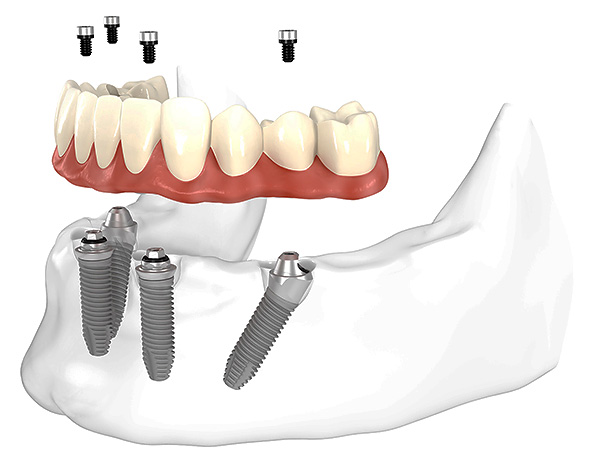
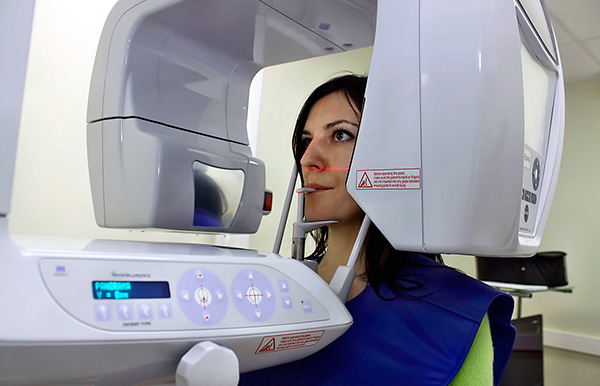
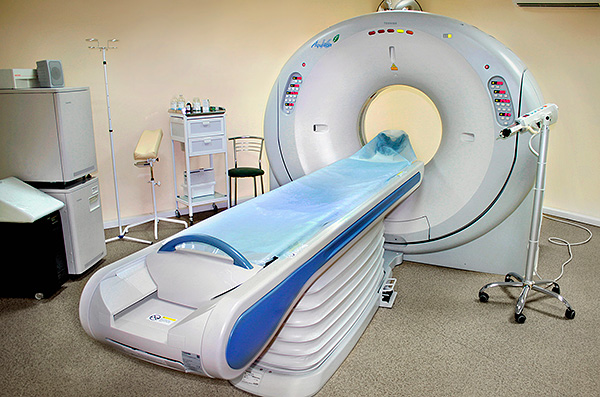
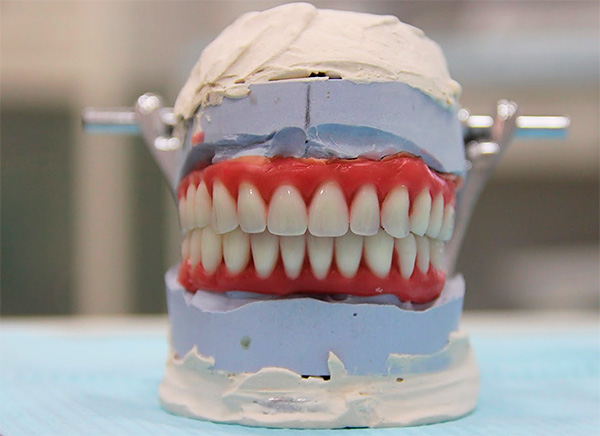
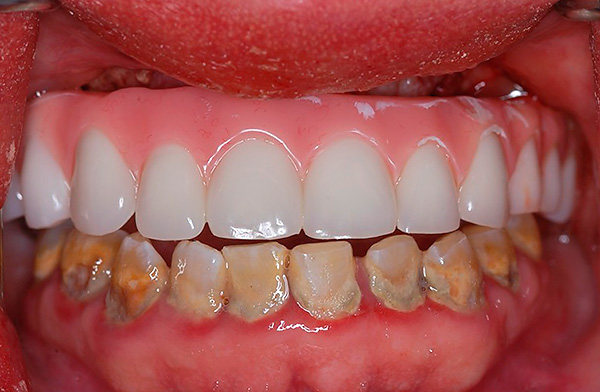
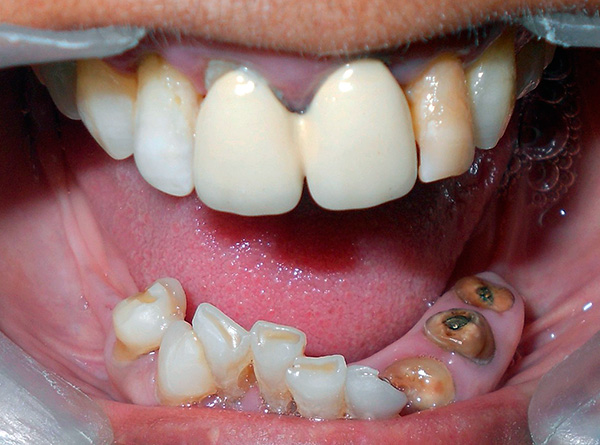
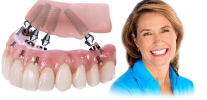
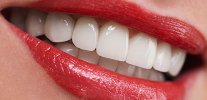
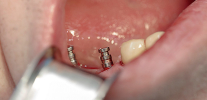
Is it true that after basal implantation, in a week you can eat and chew everything as usual? Which implants are best used for this?
Good afternoon, Victoria. Yes, you can chew, only softer food first and gradually over the course of a month you can switch to a harder one. Since the structure is connected by a metal arc, the chewing load is evenly distributed. Chewing will be painless, pain can occur only in the first days after surgery.
As for the specific types of implants and how this is all done in practice, you can find out the nuances by making an appointment with me to examine your situation in more detail. Personally, I have been working with the Oneway Biomed system for basal implantation for many years.
For a long time there are no two lower posterior teeth, I thought about implantation. I read about the manufacturers. Probably, I would like to dwell on the concept in terms of the ratio of quality and price. And basal implantation, like, is a convenient method.And here I am interested in: is it possible to put such basal implants of this system in case of a long absence of teeth?
Hello. Regarding basal implants - yes, this option is definitely possible, and it’s more correct to call it in this case implantation with immediate loading. The fact is that basal implants are installed most often with a complete absence of teeth and severe forms of bone tissue atrophy. You do not have 2 teeth, so I dare to assume that implants of other brands will suit you according to a similar technique. For example, Osstem (economy class) and Straumann (premium). Of course, if there are no other contraindications for health reasons and occlusion conditions. To accurately recommend, you need to do a CT scan and examine the oral cavity.
Regarding CONMET, I can only say that we do not work with it, as we specialize in single-stage implantation protocols, but this manufacturer does not have such implants.
Trusting basal implantation is possible only for professionals. I got five metal-ceramic teeth on the lower jaw, and they have been told that they have ten years or more of life. I think this is a long time.
Good afternoon, why are there age restrictions for this method?
Hello Vitaliy! Basal implants are placed in the cortical bone and in the bone suture areas, which form up to 20 years. Therefore, before this age, the installation of basal implants is not recommended. Further, there are no age restrictions.
It was, of course, scary, but I can say that the pain is not critical, to just horror-horror. They did anesthesia and everything went fine. In time, the operation takes about 2 hours, somehow I was given a seal longer. The only thing you need to come regularly for examinations, but I do not live in Moscow, decently leaves time.
During basal implantation, 4 implants were installed. Immediately put cermets. After 2 years, the gums sank, one implant and part of the bridge had to be cut off, as the gums were severely injured. The other implant, the doctor said, was "underwound", it also injures the gum inside.
They offer to pull everything out and do it again ... Somehow scary. How to be For me, these teeth are for beauty. Can repeated implantation be harmful?
Hello, Larisa. As a rule, basal implantation involves a primary adaptive metal-plastic bridge (long-term wear) for a period of 8 to 24 months. Since you immediately installed a permanent bridge made of cermet, the implants could be overloaded (the structure of metal-plastic is lighter and needs to be adjusted within the first year).
Repeating basal implantation again, it is better to take into account the stage of adaptive prosthetics. The operation to install basal implants is less traumatic compared to the installation of classical implants. And if everything is done according to the protocols, there should not be complications again.
It’s strange when there are all indications for basal implantation listed in the article, and many doctors offer only the classic ... With the most complete set: extension, sinus lift, and even the removal of healthy teeth - in order to put all, not segments, jaw. 3 questions arise: is it (this technique) good only on paper, or is it that we don’t know how to do it well, or do they take what is more familiar to doctors (and therefore more expensive)?
Hello Valentine. Each technique is applied individually for each clinical case, each patient has his own characteristics in the state and structure of bone tissue. Regarding the basal method, one can really say the following: implants are fixed in deep, dense areas of bone tissue, and it is not always possible to install them with your partially remaining teeth. Only a few experts are proficient in this technique.And the question here is not in financial terms, but in individual characteristics - if part of your teeth is present, then it is often recommended to do bone grafting and install classic implants. In our blade we work with several implantation methods, I invite you to a free consultation and diagnosis. We will tell you everything in detail and analyze in detail the nuances that interest you.
And where in St. Petersburg do they do basal dental implants professionally?
Hello Irina. Unfortunately, I am at a loss to suggest clinics using basal implantation in St. Petersburg. There are not many specialists in this technology. We are located in Moscow, if you wish, you can come to us for a free consultation, or you can send your OPT image and get a preliminary distance consultation.